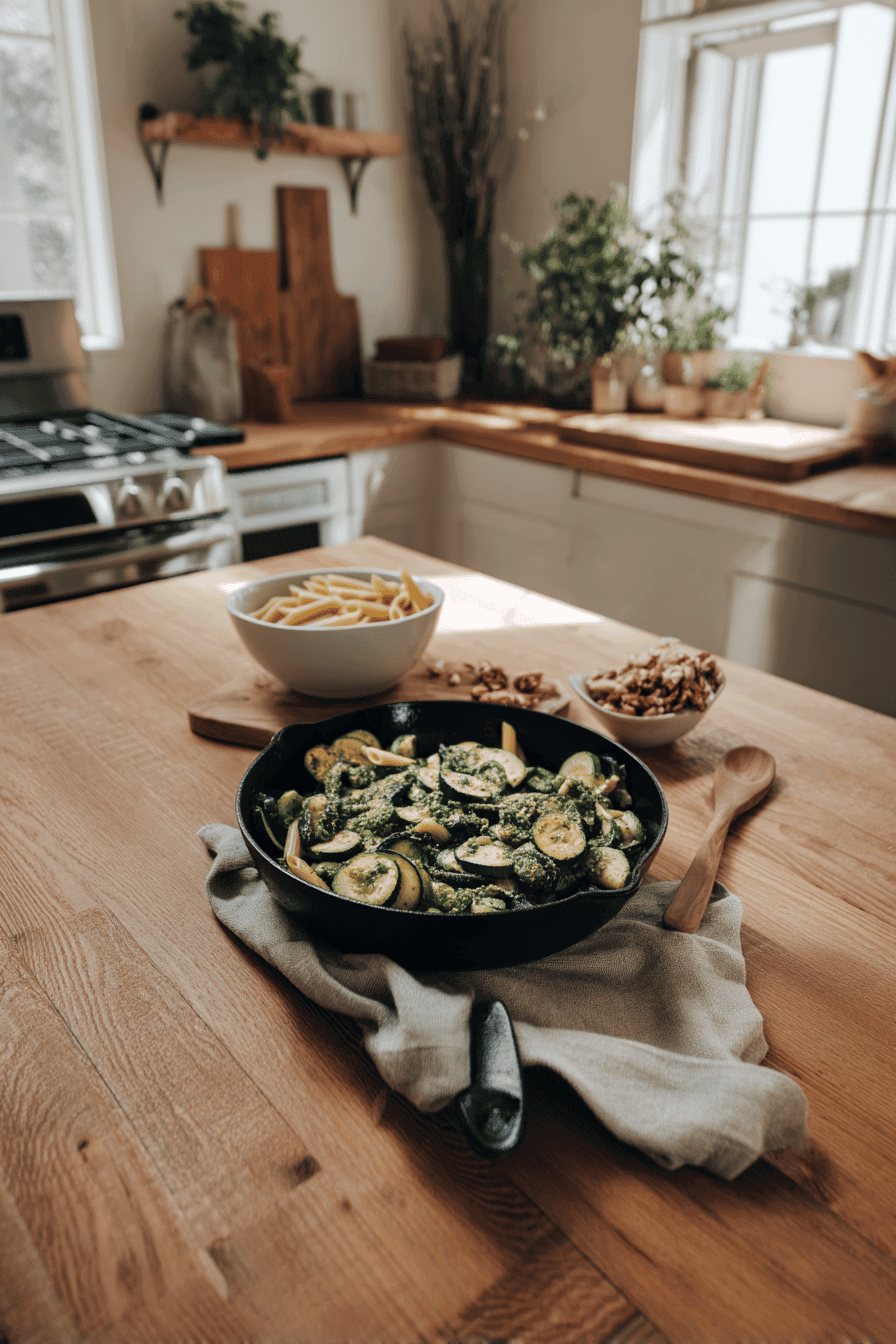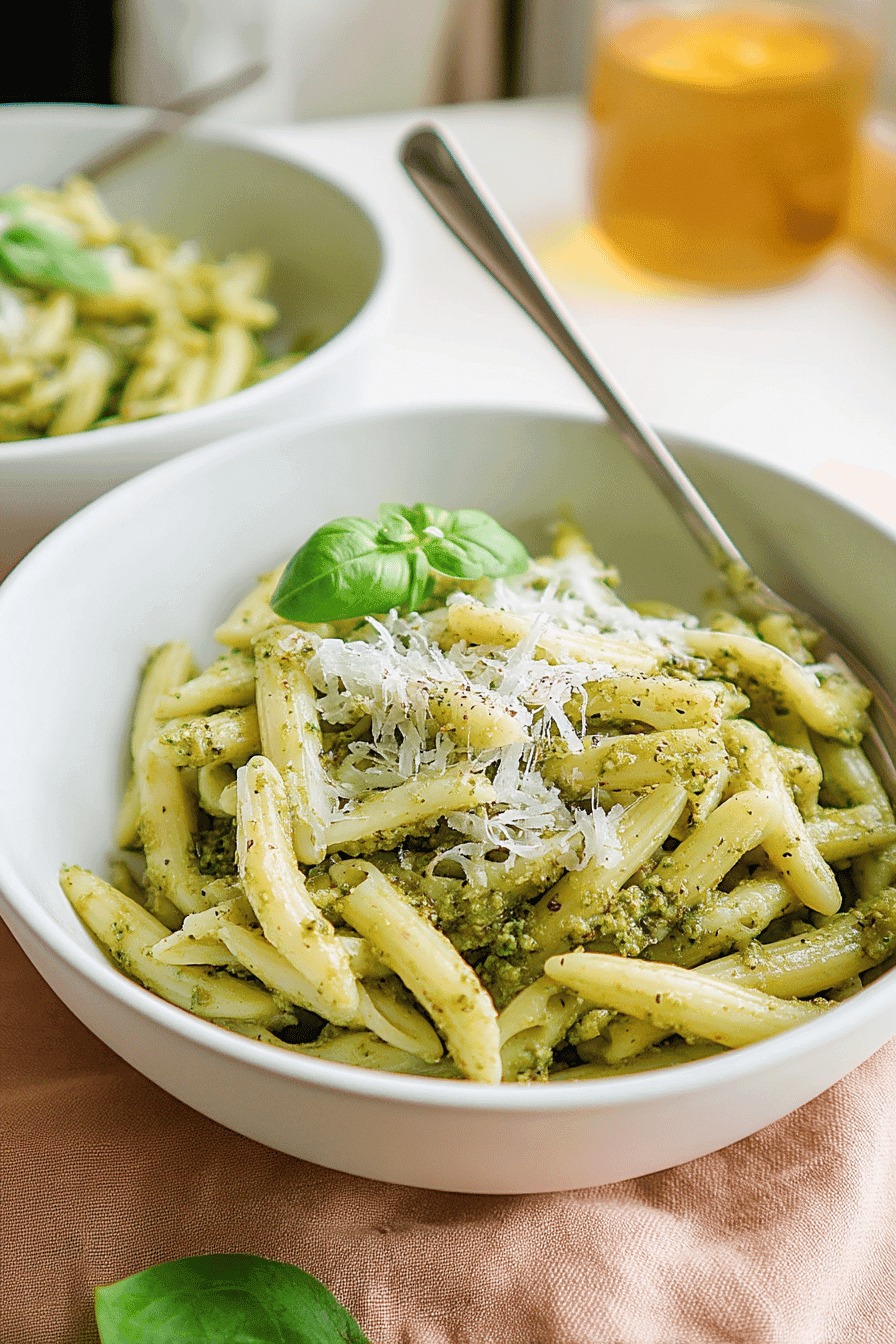Benefits and Advantages of zucchini pesto pasta
Zucchini pesto pasta is an exceptionally effective recipe due to its simplicity and numerous health benefits. The ease of preparation makes it perfect for both beginners and busy home cooks, requiring minimal ingredients and quick cooking steps. This dish is a standout because it combines the fresh, vibrant flavors of homemade pesto with the lightness of zucchini, making it a nutritious alternative to traditional pasta dishes. The zucchini adds a low-calorie component rich in vitamins and antioxidants, supporting a healthy diet while keeping the meal satisfying. Its versatility allows for various dietary preferences including vegan, gluten-free, and low-carb adaptations, appealing to a broad range of eaters. The recipe’s use of fresh herbs and nuts not only enhances the taste but also contributes heart-healthy fats and essential nutrients, making zucchini pesto pasta both delicious and beneficial for well-being. These factors together position the dish as a delicious, health-conscious choice that’s easy to incorporate into everyday meals.
Jump to:
- Benefits and Advantages of zucchini pesto pasta
- Essential Ingredients for zucchini pesto pasta
- Dietary Substitutions to Customize Your zucchini pesto pasta
- How to Prepare the Perfect zucchini pesto pasta: Step-by-Step Guide
- Mastering zucchini pesto pasta: Advanced Tips and Variations
- How to Store zucchini pesto pasta: Best Practices
- Nutritional Value of zucchini pesto pasta
- FAQs: Frequently Asked Questions About zucchini pesto pasta
- What ingredients do I need to make zucchini pesto pasta?
- How can I make zucchini pesto pasta lower in carbs?
- What is the best pasta shape to use with pesto?
- Can I use store-bought pesto for zucchini pesto pasta?
- How should I reheat zucchini pesto pasta without losing flavor or texture?
Essential Ingredients for zucchini pesto pasta
- 8 ounces dry penne pasta or similar shape (such as casarecce, shells, or rotini)
- Salt, for pasta water
- 3 medium zucchinis (about 1 1/2 pounds), sliced into half-moons or shredded
- 2 tablespoons minced garlic (or 2 cloves thinly sliced)
- 2 tablespoons olive oil (plus additional 2 tablespoons if using mushrooms or shallots)
- Salt and freshly ground black pepper, to taste
- 1 cup basil pesto (homemade or store-bought)
- 1/2 to 1 cup reserved pasta cooking water
- 1/2 cup coarsely grated Parmesan cheese (optional)
- Optional add-ins: 8 ounces mushrooms (sliced baby bella or cremini), 1/2 cup chopped shallots, 2 tablespoons unsalted butter (for sautéing and flavor), 3/4 cup toasted walnuts or pistachios (for pesto or garnish), lemon zest and juice, 1/4 cup ricotta or burrata cheese for creaminess
These ingredients together create a fresh, flavorful meal that is quick to prepare and naturally adaptable for different diets, offering a balance of textures and rich pesto flavor.

Dietary Substitutions to Customize Your zucchini pesto pasta
Customizing zucchini pesto pasta to fit dietary needs or ingredient availability is simple with these substitutions:
- Vegan: Substitute Parmesan cheese with nutritional yeast or a vegan cheese alternative, and replace butter with plant-based margarine or oil.
- Nut-free: Use sunflower seeds or pumpkin seeds in place of pine nuts or walnuts for the pesto.
- Gluten-free: Choose gluten-free pasta made from rice, quinoa, or legumes, or use spiralized zucchini noodles as a low-carb, gluten-free option.
- Low-carb/keto: Replace traditional pasta entirely with spiralized zucchini or other vegetable noodles to reduce carbohydrates.
- Flavor variation: If fresh basil is unavailable, try substituting parsley, cilantro, or mint for a different herbal note, and add lemon juice or zest for brightness.
These alternatives allow you to keep the essence and nutritional benefits of the dish while respecting various dietary restrictions and preferences.

How to Prepare the Perfect zucchini pesto pasta: Step-by-Step Guide
- Prepare the zucchini: Wash and trim zucchinis, then slice into half-moons or shred for caramelization and texture variation.
- Make the pesto: In a food processor, blend fresh basil leaves, pine nuts or walnuts, Parmesan cheese or nutritional yeast, garlic, lemon zest and juice, salt, pepper, and olive oil until smooth or slightly coarse. Adjust seasoning to taste.
- Cook the pasta: Bring salted water to a boil, cook the pasta until al dente (approximately 17 minutes), and reserve 1/2 to 1 cup pasta cooking water before draining.
- Sauté zucchini: In a large skillet, heat olive oil (plus butter if using) over medium heat. Add garlic, sauté until fragrant (about 1 minute), then stir in zucchini (and mushrooms/shallots if chosen). Season with salt and pepper and cook until tender-crisp and lightly golden (5-8 minutes).
- Combine pesto and vegetables: Stir the pesto into the zucchini mixture, cooking 1-2 minutes to blend flavors.
- Toss pasta with sauce: Add the drained pasta to the skillet and gently combine. Gradually add reserved pasta water as needed to create a glossy, cohesive sauce.
- Finish and serve: Serve hot, optionally topped with grated Parmesan, dollops of ricotta or burrata, and toasted nuts for added texture and richness.
Following these steps ensures a vibrant, flavorful, and creamy zucchini pesto pasta that satisfies diverse palates and dietary goals alike.
Mastering zucchini pesto pasta: Advanced Tips and Variations
To bring your zucchini pesto pasta to new heights, consider several flavor and texture enhancements. Toasting nuts like walnuts or pistachios before blending them into the pesto deepens the sauce’s aroma and adds a subtle smoky note. Experimenting with fresh herbs besides basil, such as parsley or mint, can give your pesto a refreshing twist. For a creamier sauce, blend in ripe avocado or a splash of plant-based milk, which balances the pesto’s herbaceous flavors with a velvety texture.
Adding seasonal vegetables like sautéed cherry tomatoes, mushrooms, or asparagus provides pleasing variety and nutrition. Using different pasta shapes casarecce, shells, or rotini helps capture the sauce for better mouthfeel. You might also try serving the dish chilled as a pasta salad, dressed with a bit more olive oil and lemon zest for brightness. These variations maintain the recipe’s simplicity while broadening its appeal and adaptability.
How to Store zucchini pesto pasta: Best Practices
Proper storage keeps your zucchini pesto pasta flavorful and fresh. Store leftovers in air-tight containers in the refrigerator and consume within 2-3 days for optimal quality. To freeze, it’s advisable to separate the pesto sauce and pasta or zucchini noodles: freeze the pesto in a sealed container and blanch the noodles briefly before freezing to preserve texture.
When reheating, warm the pasta gently on the stove over low heat or in the microwave, adding a splash of reserved pasta water or olive oil to maintain moisture and prevent drying out. Avoid overcooking on reheating to keep the zucchini tender yet crisp and the pesto bright. These storage methods allow convenient meal prep without sacrificing the dish’s fresh flavors.
Nutritional Value of zucchini pesto pasta
| Nutrient | Amount per Serving (Approx.) | Health Benefit |
|---|---|---|
| Calories | 300–400 kcal | Provides balanced energy from fats, protein, and carbs |
| Protein | 8–12 g | Supports muscle maintenance and satiety |
| Fat (mostly unsaturated) | 15–20 g | Heart-healthy fats from olive oil and nuts |
| Carbohydrates | Moderate; lower with zucchini noodles | Complex carbs supply steady energy |
| Vitamins A & C | Significant | Antioxidant support and immune health |
| Magnesium & Potassium | Present | Support metabolic processes and electrolyte balance |
This nutrient-dense dish blends the benefits of fresh vegetables, heart-healthy fats, and protein. The Health Benefits of Zucchini and the freshness of basil pesto (How to Make Basil Pesto) contribute to both flavor and wellness, making zucchini pesto pasta a great choice for health-conscious eaters.








